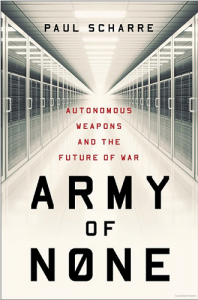(Editor’s Note: Beginning today, the Mad Science Laboratory will publish a monthly post listing the most compelling articles, books, podcasts, videos, and/or movies that the U.S. Army’s Training and Doctrine Command (TRADOC) Mad Scientist Initiative has come across during the previous month. In this anthology, we will address how each of these works either informs or challenges our understanding of the Future Operational Environment. We hope that you will add “The Queue” to your essential reading, listening, or watching each month!)
 1. Army of None: Autonomous Weapons and the Future of War, by Paul Scharre, Senior Fellow and Director of the Technology and National Security Program, Center for a New American Security.
1. Army of None: Autonomous Weapons and the Future of War, by Paul Scharre, Senior Fellow and Director of the Technology and National Security Program, Center for a New American Security.
One of our favorite Mad Scientists, Paul Scharre, has authored a must read for all military Leaders. This book will help Leaders understand the definitions of robotic and autonomous weapons, how they are proliferating across states, non-states, and super-empowered individuals (his chapter on Garage Bots makes it clear this is not state proliferation analogous), and lastly the ethical considerations that come up at every Mad Scientist Conference. During these Conferences, we have discussed the idea of algorithm vs algorithm warfare and what role human judgement plays in this version of future combat. Paul’s chapters on flash war really challenge our ideas of how a human operates in the loop and his analogies using the financial markets are helpful for developing the questions needed to explore future possibilities and develop policies for dealing with warfare at machine speed.

April 2018 marked the fifth anniversary of the Campaign to Stop Killer Robots. Earlier this month, 82 countries and numerous NGOs also convened at the Convention on Certain Conventional Weapons (CCW) in Geneva, Switzerland, where many stressed the need to retain human control over weapons systems and the use of force. While the majority in attendance proposed moving forward this November to start negotiations towards a legally binding protocol addressing fully autonomous weapons, five key states rejected moving forward in negotiating new international law – France, Israel, Russia, the United Kingdom, and the United States. Mad Scientist notes that the convergence of a number of emerging technologies (synthetic prototyping, additive manufacturing, advanced modeling and simulations, software-defined everything, advanced materials) are advancing both the feasibility and democratization of prototype warfare, enabling and improving the engineering of autonomous weapons by non-state actors and super-empowered individuals alike. The genie is out of the bottle – with the advent of the Hyperactive Battlefield, advanced engagements will collapse the decision-action cycle to mere milliseconds, granting a decisive edge to the side with more autonomous decision-action.

Mad Scientist Elsa Kania addresses the People’s Republic of China’s apparent juxtaposition between their diplomatic commitment to limit the use of fully autonomous lethal weapons systems and the PLA’s active pursuit of AI dominance on the battlefield. The PRC’s decision on lethal autonomy and how it defines the role of human judgement in lethal operations will have tactical, operational, and strategic implications. In TRADOC’s Changing Character of Warfare assessment, we addressed the idea of an asymmetry in ethics where the differing ethical choices non-state and state adversaries make on the integration of emerging technologies could have real battlefield overmatch implications. This is a clear pink flamingo where we know the risks but struggle with addressing the threat. It is also an area where technological surprise is likely, as systems could have the ability to move from human in the loop mode to fully autonomous with a flip of a switch.

While this article focuses primarily on a higher-level philosophical interpretation of human vs. machine (or artificial intelligence, being, etc.), the core arguments and discussion remain relevant to an Army that is looking to increase its reliance on artificial intelligence and robotics. Technological advancements in these areas continue to trend toward modeling humans (both in form and the brain). However, the closer we get to making this a reality, the closer we get to confronting questions about consciousness and artificial humanity. Are we prepared to face these questions earnestly? Do we want an artificial entity that is, essentially, human? What do we do when that breakthrough occurs? Does biological vs. synthetic matter if the being “achieves” personhood? For additional insights on this topic, watch Linda MacDonald Glenn‘s Ethics and Law around the Co-Evolution of Humans and AI presentation from the Mad Scientist Visualizing Multi Domain Battle in 2030-2050 Conference at Georgetown University, 25-26 Jul 17.
 5. Do You Trust This Computer?, directed by Chris Paine, Papercut Films, 2018.
5. Do You Trust This Computer?, directed by Chris Paine, Papercut Films, 2018.
The Army, and society as a whole, is continuing to offload certain tasks and receive pieces of information from artificial intelligence sources. Future Army Leaders will be heavily influenced by AI processing and distributing information used for decision making. But how much trust should we put in the information we get? Is it safe to be so reliant? What should the correct ratio be of human/machine contribution to decision-making? Army Leaders need to be prepared to make AI one tool of many, understand its value, and know how to interpret its information, when to question its output, and apply appropriate context. Elon Musk has shown his support for this documentary and tweeted about its importance.
 6. Ready Player One, directed by Steven Spielberg, Amblin Entertainment, 2018.
6. Ready Player One, directed by Steven Spielberg, Amblin Entertainment, 2018.
Adapted from the novel of the same name, this film visualizes a future world where most of society is consumed by a massive online virtual reality “game” known as the OASIS. As society transitions from the physical to the virtual (texting, email, skype, MMORPG, Amazon, etc.), large groups of people will become less reliant on the physical world’s governmental and economic systems that have been established for centuries. As virtual money begins to have real value, physical money will begin to lose value. If people can get many of their goods and services through a virtual world, they will become less reliant on the physical world. Correspondingly, physical world social constructs will have less control of the people who still inhabit it, but spend increasing amounts of time interacting in the virtual world. This has huge implications for the future geo-political landscape as many varied and geographically diverse groups of people will begin congregating and forming virtual allegiances across all of the pre-established, but increasingly irrelevant physical world geographic borders. This will dilute the effectiveness, necessity, and control of the nation-state and transfer that power to the company(ies) facilitating the virtual environment.

As if Boston Dynamic’s SpotMini isn’t creepy enough, the U.S. Army Research Laboratory (ARL) and the University of Minnesota are developing a flexible, soft robot inspired by squid and other invertebrates that Soldiers can create on-demand using 3-D printers on the battlefield. Too often, media visualizations have conditioned us to think of robots in anthropomorphic terms (with corresponding limitations). This and other breakthroughs in “soft,” polymorphic, printable robotics may grant Soldiers in the Future Operational Environment with hitherto unimagined on-demand, tailorable autonomous systems that will assist operations in the tight confines of complex, congested, and non-permissive environments (e.g., dense urban and subterranean). Soft robotics may also prove to be more resilient in arduous conditions. This development changes the paradigm for how robotics are imagined in both design and application.
If you read, watch, or listen to something this month that you think has the potential to inform or challenge our understanding of the Future Operational Environment, please forward it (along with a brief description of why its potential ramifications are noteworthy to the greater Mad Scientist Community of Action) to our attention at: usarmy.jble.tradoc.mbx.army-mad-scientist@mail.mil — we may select it for inclusion in our next edition of “The Queue”!
For additional insights into the Mad Scientist Initiative and how we continually explore the future through collaborative partnerships and continuous dialogue with academia, industry, and government, check out this Spy Museum’s SPYCAST podcast.




Regarding autonomous warfare, I recommend reading Daniel Suarez’s near future science-fiction books Daemon, Freedom(TM), and Kill Decision. The first two feature a pre-programmed semi-autonomous game that executes a series of deadly attacks after the programmer dies. Some of the deadliest weapons are re-programmed autonomous cars.
Kill Decision is about drone aircraft and hive-mind AI modeled after an ant colony.